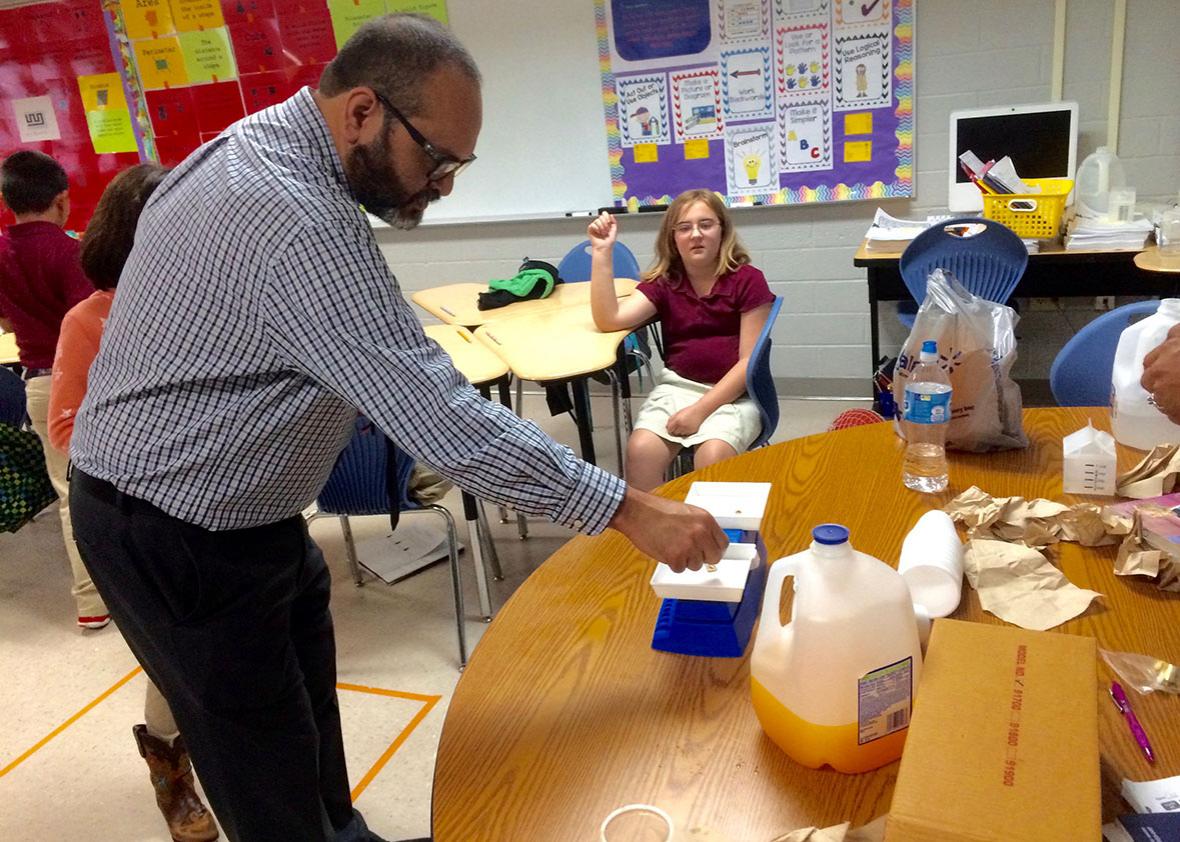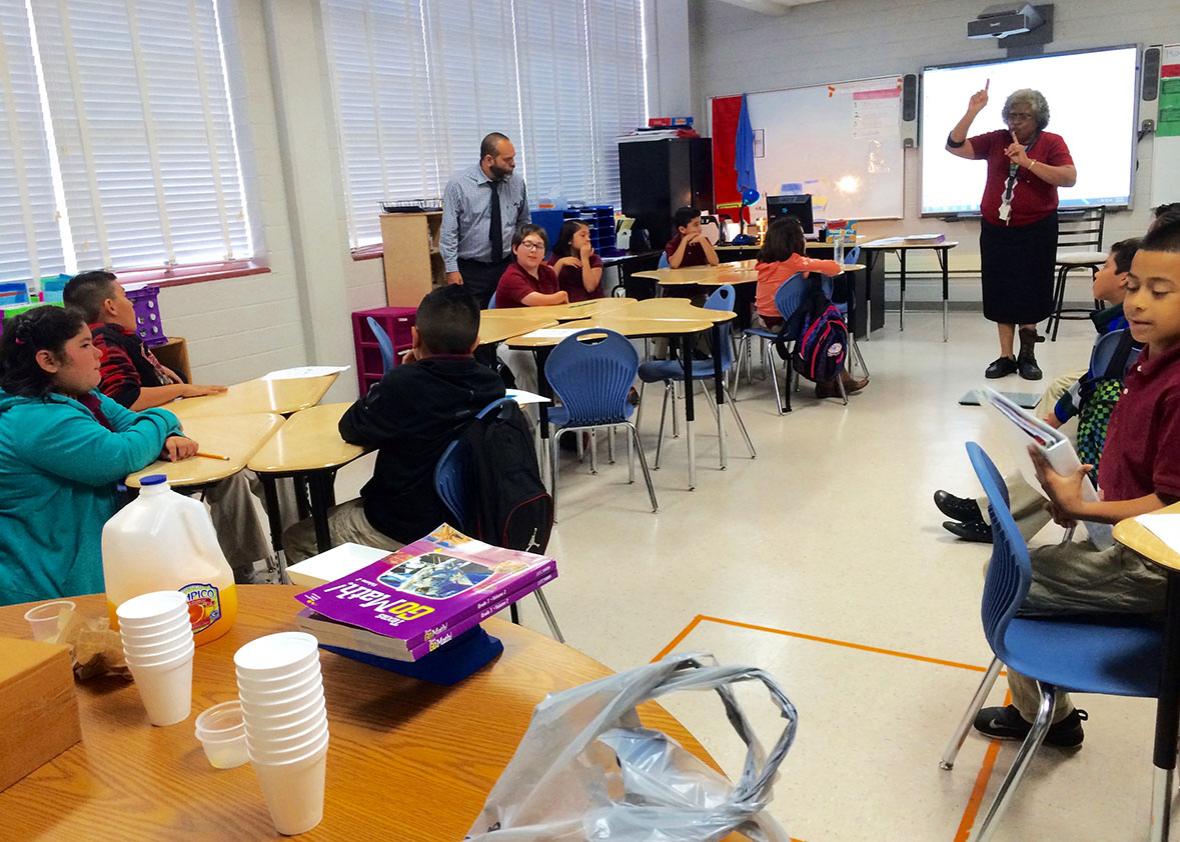This story was produced by the Hechinger Report, a nonprofit, independent news organization focused on inequality and innovation in education. Read more about the Common Core.
SAN ANTONIO—Karen Demore booms. She stomps. She makes a mess. She’s one of those teachers kids can’t get enough of.
On a recent Tuesday, she stood at the back of her cluttered third-grade math classroom, presiding over a set of scales weighed down on one side with two textbooks—1 kilogram total. The kids ran around the room, eagerly looking for objects that would balance the other side. They jostled into a line and then took turns gingerly placing their chosen objects on the scale.
A bottle of water?
“NO!” Demore bellowed.
A pile of notebooks?
“NO!”
A jug of orange juice?
“NO!”
The third-graders giggled as, one after another, they failed. As Demore moved on to the next part of the lesson, the textbooks stayed closed. Instead, she directed two students to flip a desk and balance it upside down on a step scale. Giovanni Avila, 8, grinned. “Miss, this is fun!” he said.

Sarah Garland
Demore, a 28-year teaching veteran, most recently taught seventh-grade math. But this year, New Frontiers Charter School in San Antonio needed its best teachers to help younger students get ready for a new set of math standards Texas adopted in 2012, so Demore switched to elementary school. It’s the second year the standards are being tested but the first the scores will count for schools.
The Texas standards aren’t the same as the Common Core State Standards Initiative, adopted by more than 40 states. It’s actually illegal to teach Common Core in Texas.
But even in a state that said an emphatic “No!” to Common Core, the new math standards here are pretty similar to the standards the state rejected, experts say. Across the Lone Star State, as in the rest of the nation, number lines are replacing pizzas in lessons about fractions and lectures are losing out to rambunctious lessons in which kids seem to run the show.
And more teachers here are overhauling math class so that it’s not just about getting answers right or wrong; it’s about the joy and challenge of hunting for a solution, whether or not students find it on the first try.
“Really that’s what I was going for. Not that they would get it. That if this is too heavy, I need to find something lighter,” Demore said later about the lesson. “The idea of looking, of inquiring, of trying. The idea of the journey. It may or may not lead to a right answer, but it will certainly lead to better thinking and reasoning. And that’s one of the things they need to get to.”
That idea reflects a consensus across the U.S. and is the reason math classes everywhere are starting to look more alike, even in schools untouched by the Common Core.
“There is a much greater research base about how children learn … mathematical functions than existed 20, 30 years ago,” said Mark Ellis, a professor of math education at California State University–Fullerton. “The overall picture of what mathematics looks like is converging on this idea that it’s not the teacher standing there for 30 minutes, then giving you 20 problems to replicate the algorithm.”
Taking a break from test prep this spring, Shealah Guerro, a 9-year-old fourth-grader in a maroon uniform and shiny turquoise sneakers, paused to talk in the hall with the New Frontiers Elementary Principal Ruben Pesina. Shealah told her principal she was most nervous about the English test.
“The math is kind of easy for me,” she said. “I’m really good at math.”
That’s a big deal for Pesina, who felt the exact opposite about the tests. The school, which serves a mostly Hispanic student population in a low-income neighborhood in south San Antonio, was cited as needing improvement after the new standards were introduced.
“I’m really glad to hear Shealah, who struggles, say she gets it,” Pesina said. “We care about writing, but what I’m really worried about is math.”
“They’ve been doing more hands-on activities, so maybe that’s why,” he added.
The Texas standards reference “Adding It Up,” a major 2001 study by the National Research Council about how children learn math, a study also explicitly cited by the Common Core standards writers. In it, researchers noted that in the past, most American math classes were structured around textbooks. “Depth is seldom achieved, and mastery deferred,” they wrote of the practice. The recommendations to improve math instruction included reducing the number of standards covered; cutting down on constant review; and remaking classrooms into “communities of learners,” not “collections of isolated individuals.”
The common research base has resulted in a lot more similarities than differences between Common Core states and states such as Texas and Nebraska that never adopted the standards. For example, the standards for understanding mathematical process (including being able to analyze mathematical relationships and using tools to solve problems) in the Texas Essential Knowledge and Skills standards, known as TEKS, are quite similar to the Common Core’s standards for mathematical practice, Ellis said.
“There’s a lot of overlap because they’re basing this on the same body of research and knowledge about what’s going to support our students in becoming mathematically powerful,” Ellis said.
The actual content, or knowledge, students are expected to gain by the end of each grade also tends to match, as states have sought to build up what kids need to know to tackle algebra by high school.
In third grade, for example, the big topics in Texas are place value, whole number operations (addition, subtraction, multiplication and division), and fractions. One of the old TEKS standards expected students simply to “construct concrete models of fractions.”
The new Texas standard is more explicit: “The student is expected to represent fractions greater than zero and less than or equal to one with denominators of 2, 3, 4, 6, and 8 using concrete objects and pictorial models, including strip diagrams and number lines.”
Under Common Core, number lines have also received major emphasis as one of three main ways kids are supposed to learn about fractions in third grade.

Sarah Garland
In both the Common Core and Texas standards, concepts were also streamlined, and some were moved to lower grades—in Texas, as far as two grades, according to Demore, who has studied both sets of standards. She said, however, that “the Common Core standards are much more rigorous on every grade level. The Texas state standards don’t match that level of rigor.”
(The writers of the Common Core standards say that the goal is instilling “a deep, authentic command of mathematical concepts, not making math harder or introducing topics at earlier grades.”)
“If we assume that our kids are going to live and work their entire lives in Texas, it’s fine,” Demore added. “If they’re going to go and work somewhere else out of the state of Texas, their foundation is not as strong, which unfortunately decreases educational possibilities for them, and that’s not fair at all.”
One reviewer of an early draft of the Texas math standards, R. James Milgram, a professor emeritus in the Stanford University math department, said the standards were so similar to Common Core that Texas might as well have adopted those standards instead of creating its own. Milgram has been an outspoken critic of Common Core, as the review he wrote for the Texas Education Agency on the draft of the new standards makes clear. But still, Texas’ are worse.
“Overall, I find [the Texas] standards very disappointing, and feel that there are sufficient problems with them that the best course would be to simply adopt the new Core Standards which, in spite of their many problems, are far better and much more mathematically literate and coherent than this document,” Milgram wrote .
“When it comes to content, it is not terribly different than the Common Core,” said Wilfried Schmid, a Harvard mathematician and another official reviewer of the Texas standards, in an interview. “The results show that they looked at Common Core and rephrased it in their own terms.”
DeEtta Culbertson, a spokeswoman for the Texas Education Agency, said the process of creating the Texas standards included multiple rounds of feedback from teachers, professors, math experts, and community members. “The biggest thing was making sure the students can learn it, that it’s aligned to the college and career readiness standards, and ensuring that vertical alignment. And that it can be taught in a reasonable amount of time,” she said.
Schmid and Milgram did praise Texas for one major difference: Common Core includes more guidance on pedagogy, something the mathematicians said Texas was smart to avoid.
But Demore says even without explicit directions about how to teach, the new Texas standards are pushing teachers to run their classrooms differently—and she thinks that’s a good thing.
“I literally think about my standards, not only with every lesson I plan, but with how I go about conducting that lesson,” she said. The new standards “will leave them as much better problem solvers later on. They will have a foundation of problem solving and reasoning that’s super strong.”
This story was produced by the Hechinger Report, a nonprofit, independent news organization focused on inequality and innovation in education. Read more about the Common Core.
